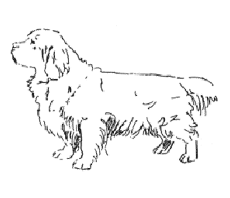Clumber Spaniel
General Information - Clumber Spaniel

Group:
Gundog
Size:
large
Lifespan:
10-12 years
Exercise:
low
Grooming:
medium
Trainability:
medium
Watchdog ability:
low
Protection ability:
very low
Area of Origin:
England
Date of Origin:
1700s
Other Names:
none
Original Function:
bird flushing and
retrieving
History
The first Clumber Spaniels originated in France, but were moved to sanctuary in England during the French Revolution. They were in the care of the Duke of Newcastle at Clumber Park, hence the name. This sturdy spaniel is the slowest and heaviest of the spaniels, but works well in heavy brush, flushing and retrieving game. Though the Clumber's early history is not well documented, Basset Hounds and St. Bernards may have contributed to the breed.
Temperament
Steady, reliable, kind and dignified; more aloof than other Spaniels, showing no tendency towards aggression.
Upkeep
The Clumber enjoys a daily outing, but its exercise requirements can be met with a long walk on leash or a leisurely hike in the field. The coat needs brushing two to three times weekly, although in dirty areas it may need more frequent bathing in order to keep its coat a gleaming white. Clumbers tend to drool and, at times, snore.
Clumber Spaniel
A breed standard is the guideline which describes the ideal characteristics, temperament, and appearance of a breed and ensures that the breed is fit for function with soundness essential. Breeders and judges should at all times be careful to avoid obvious conditions and exaggerations, as well as being mindful of features which could be detrimental in any way to the health, welfare or soundness of this breed.
Breed Standard - Clumber Spaniel
 General Appearance:
General Appearance: Well balanced, heavily boned, active with a thoughtful expression, overall appearance denoting strength.
Characteristics: Stoical, great:hearted, highly intelligent with a determined attitude enhancing his natural ability. A silent worker with an excellent nose.
Temperament: Steady, reliable, kind and dignified; more aloof than other Spaniels, showing no tendency towards aggression.
Head and Skull: Square, massive, medium length, broad on top with decided occiput; heavy brows; deep stop. Heavy, square muzzle with well-developed flews. No exaggeration in head and skull.
Eyes: Clean, dark, amber, slightly sunk, some haw showing but without excess. Full light eyes highly undesirable. Free from entropion.
Ears: Large, vine leaf:shaped, well covered with straight hair. Hanging slightly forward, feather not to extend below leather.
Mouth: Jaws strong, with a perfect, regular and complete scissor bite, i.e. upper teeth closely overlapping lower teeth and set square to the jaws.
Neck: Fairly long, thick, powerful.
Forequarters: Shoulders strong, sloping, muscular; legs short, straight, well boned, strong.
Body: Long, heavy, near to ground. Chest deep. Well sprung ribs. Back straight, broad, long. Muscular loin, well let down in flank.
Hindquarters: Very powerful and well developed. Hocks low, stifles well bent and set straight.
Feet: Large, round, well covered with hair.
Tail: Customarily docked.
Docked - Set low. Well feathered, carried level with back.
Undocked - Set low. Well feathered, carried level with back.
Gait/movement: Rolling gait attributable to long body and short legs. Moving straight fore and aft, with effortless drive.
Coat: Abundant, close, silky and straight. Legs and chest well feathered.
Colour: Plain white body preferred, with lemon markings; orange permissible. Slight head markings and freckled muzzle.
Size: Ideal Weight - dogs: 36 kgs (80 lbs); bitches: 29.5 kgs (65 lbs).
Faults: Any departure from the foregoing points should be considered a fault and the seriousness with which the fault should be regarded should be in exact proportion to its degree and its effect upon the health and welfare of the dog.
Note: Male animals should have two apparently normal testicles fully descended into the scrotum.
DNZ No 340
Copyright Dogs New Zealand
23 Dec 2013
Any departure from the foregoing points should be considered a fault and the seriousness with which the fault should be regarded should be in exact proportion to its degree and its effect upon the health and welfare of the dog and on the dog’s ability to perform its traditional work.




